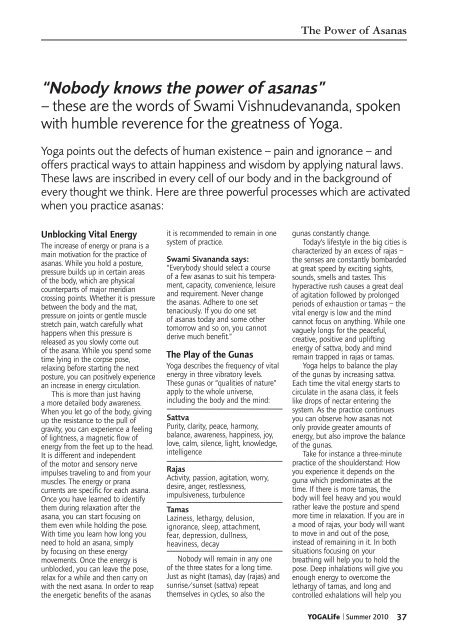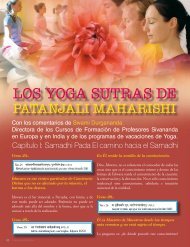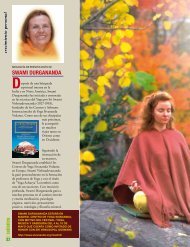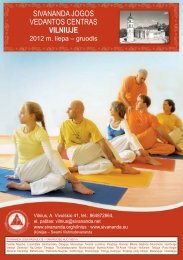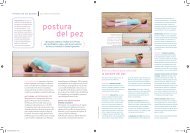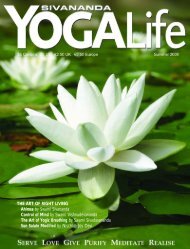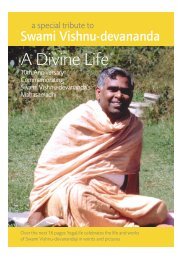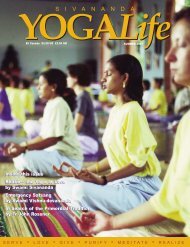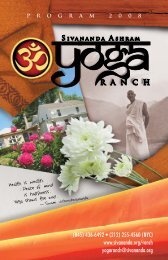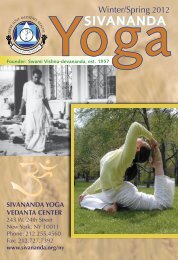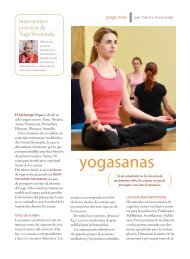YOGALife I Summer 2010 - Sivananda Yoga
YOGALife I Summer 2010 - Sivananda Yoga
YOGALife I Summer 2010 - Sivananda Yoga
You also want an ePaper? Increase the reach of your titles
YUMPU automatically turns print PDFs into web optimized ePapers that Google loves.
Unblocking Vital Energy<br />
The increase of energy or prana is a<br />
main motivation for the practice of<br />
asanas. While you hold a posture,<br />
pressure builds up in certain areas<br />
of the body, which are physical<br />
counterparts of major meridian<br />
crossing points. Whether it is pressure<br />
between the body and the mat,<br />
pressure on joints or gentle muscle<br />
stretch pain, watch carefully what<br />
happens when this pressure is<br />
released as you slowly come out<br />
of the asana. While you spend some<br />
time lying in the corpse pose,<br />
relaxing before starting the next<br />
posture, you can positively experience<br />
an increase in energy circulation.<br />
This is more than just having<br />
a more detailed body awareness.<br />
When you let go of the body, giving<br />
up the resistance to the pull of<br />
gravity, you can experience a feeling<br />
of lightness, a magnetic flow of<br />
energy from the feet up to the head.<br />
It is different and independent<br />
of the motor and sensory nerve<br />
impulses traveling to and from your<br />
muscles. The energy or prana<br />
currents are specific for each asana.<br />
Once you have learned to identify<br />
them during relaxation after the<br />
asana, you can start focusing on<br />
them even while holding the pose.<br />
With time you learn how long you<br />
need to hold an asana, simply<br />
by focusing on these energy<br />
movements. Once the energy is<br />
unblocked, you can leave the pose,<br />
relax for a while and then carry on<br />
with the next asana. In order to reap<br />
the energetic benefits of the asanas<br />
it is recommended to remain in one<br />
system of practice.<br />
Swami <strong>Sivananda</strong> says:<br />
“Everybody should select a course<br />
of a few asanas to suit his tempera -<br />
ment, capacity, convenience, leisure<br />
and requirement. Never change<br />
the asanas. Adhere to one set<br />
tenaciously. If you do one set<br />
of asanas today and some other<br />
tomorrow and so on, you cannot<br />
derive much benefit.”<br />
The Play of the Gunas<br />
<strong>Yoga</strong> describes the frequency of vital<br />
energy in three vibratory levels.<br />
These gunas or “qualities of nature”<br />
apply to the whole universe,<br />
including the body and the mind:<br />
Sattva<br />
Purity, clarity, peace, harmony,<br />
balance, awareness, happiness, joy,<br />
love, calm, silence, light, knowledge,<br />
intelligence<br />
Rajas<br />
Activity, passion, agitation, worry,<br />
desire, anger, restlessness,<br />
impulsiveness, turbulence<br />
Tamas<br />
Laziness, lethargy, delusion,<br />
ignorance, sleep, attachment,<br />
fear, depression, dullness,<br />
heaviness, decay<br />
Nobody will remain in any one<br />
of the three states for a long time.<br />
Just as night (tamas), day (rajas) and<br />
sunrise/sunset (sattva) repeat<br />
themselves in cycles, so also the<br />
The Power of Asanas<br />
“Nobody knows the power of asanas”<br />
– these are the words of Swami Vishnudevananda, spoken<br />
with humble reverence for the greatness of <strong>Yoga</strong>.<br />
<strong>Yoga</strong> points out the defects of human existence – pain and ignorance – and<br />
offers practical ways to attain happiness and wisdom by applying natural laws.<br />
These laws are inscribed in every cell of our body and in the background of<br />
every thought we think. Here are three powerful processes which are activated<br />
when you practice asanas:<br />
gunas constantly change.<br />
Today’s lifestyle in the big cities is<br />
characterized by an excess of rajas –<br />
the senses are constantly bombarded<br />
at great speed by exciting sights,<br />
sounds, smells and tastes. This<br />
hyperactive rush causes a great deal<br />
of agitation followed by prolonged<br />
periods of exhaustion or tamas – the<br />
vital energy is low and the mind<br />
cannot focus on anything. While one<br />
vaguely longs for the peaceful,<br />
creative, positive and uplifting<br />
energy of sattva, body and mind<br />
remain trapped in rajas or tamas.<br />
<strong>Yoga</strong> helps to balance the play<br />
of the gunas by increasing sattva.<br />
Each time the vital energy starts to<br />
circulate in the asana class, it feels<br />
like drops of nectar entering the<br />
system. As the practice continues<br />
you can observe how asanas not<br />
only provide greater amounts of<br />
energy, but also improve the balance<br />
of the gunas.<br />
Take for instance a three-minute<br />
practice of the shoulderstand: How<br />
you experience it depends on the<br />
guna which predominates at the<br />
time. If there is more tamas, the<br />
body will feel heavy and you would<br />
rather leave the posture and spend<br />
more time in relaxation. If you are in<br />
a mood of rajas, your body will want<br />
to move in and out of the pose,<br />
instead of remaining in it. In both<br />
situations focusing on your<br />
breathing will help you to hold the<br />
pose. Deep inhalations will give you<br />
enough energy to overcome the<br />
lethargy of tamas, and long and<br />
controlled exhalations will help you<br />
<strong>YOGALife</strong> I <strong>Summer</strong> <strong>2010</strong> 37


